All about Pelargoniums "Angel"

In search of a successful option for landscaping a house or apartment, flower growers often choose beautiful sophisticated flowers. One of these colors is Pelargonium "Angel", which will be discussed in this article.

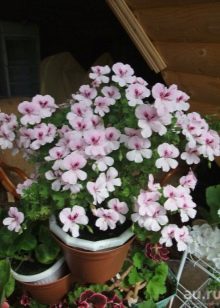

Origin
Pelargonium is a perennial that is a close relative of the well-known geranium. An interesting fact: the crane, which is found everywhere in the meadows and forests of central Russia, is, in fact, a real geranium. And favorite indoor "geraniums" are pelargoniums.
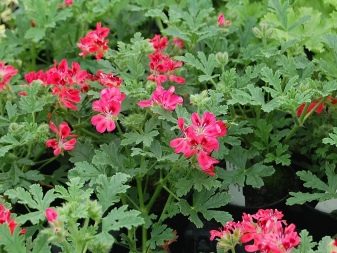

The first specimens were brought from South Africa, they gave rise to all modern varieties. It is believed that the species familiar to many growers, first of all, blooms effectively. There are also fragrant varieties, whose carved leaves have a pleasant smell of apple, lemon, mint. They fill sachets and gift baskets, make boutonnieres. Inflorescences on a fragrant bush are medium-sized, there are not always many of them.
The group includes many types that differ:
- by the shape and color of the leaves;
- by type, size and color of flowers;
- in the direction of growth of the bush.
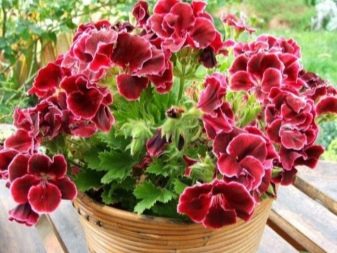

There are plants that resemble tulips and roses. A variety similar to viols (pansies) was named "Angel". It appeared as a result of crossing the royal and curly varieties. The hybrid inherited from the curly ancestor a delicate lemon scent and bright green "lace" leaves, and from the royal one - lush and abundant flowering. It was bred in the 30s of the last century by the English breeder Arthur Langley-Smith.
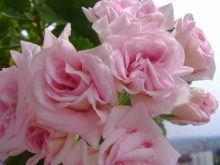
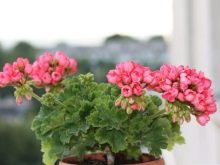
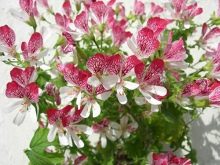
Key Features
Pelargonium "Angel" is a bush about 30 cm high, but there are representatives up to 60 cm in height. The woody and narrow stems are covered with many leaves and form a green head. Some species have tiny fluffy hairs on the surface that exude a fresh scent. The buds are elongated, with sharp tips, and collected in inflorescences. They are so similar during flowering to violets and pansies that in stores they are sometimes sold under the name "Viola".
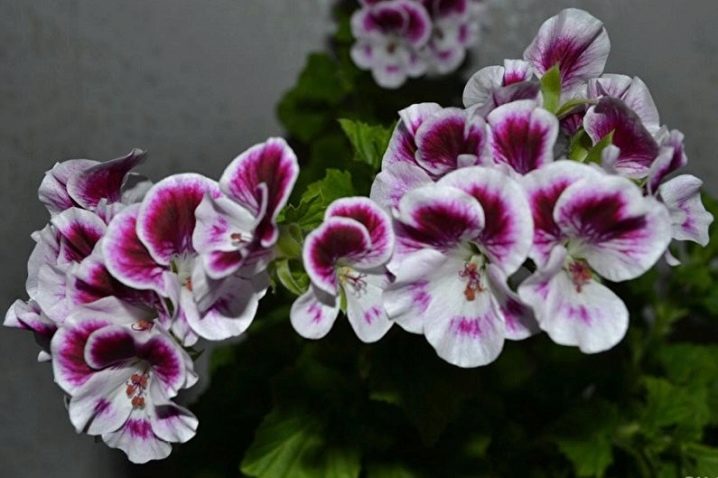
Among other pelargoniums "Angel" stands out for the difference in the color of the upper and lower petals. There are usually five of them: two upper and three lower, the lower ones are not so large and are fanned out. There are variations with pink, lilac, white, scarlet, purple, burgundy shades. Often the flowers are bicolor (painted in two colors): pink / burgundy, lilac / purple, white / fuchsia. There are tricolor colors, for example, "Debbie", combining burgundy, pink and white tones.
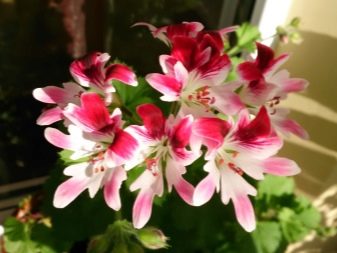
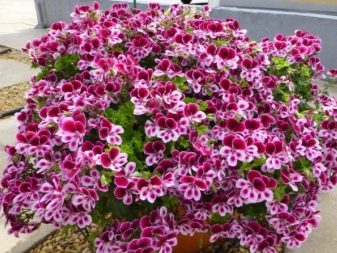
Despite the fantastic color combinations, one should not expect the richness of the royal geranium color palette from the variety, with which it is often confused. Another important difference is the smaller leaves and inflorescences. Hybrids are found in home gardens on the windowsill.
Varieties
Let's consider some of the most popular varieties of "Angel" today.
- "Angel Burgundy". "Burgundy" has almost no white spots on the flowers, the color of the petals varies from dark scarlet on the top, and bright pink on the bottom. It blooms profusely with bright "viols", sparkling shades of pink, and pleases its owners about 9 months a year.
In summer, it is advised to take the container out to the balcony or veranda, it feels uncomfortable in the garden, does not like cold rains and wind.

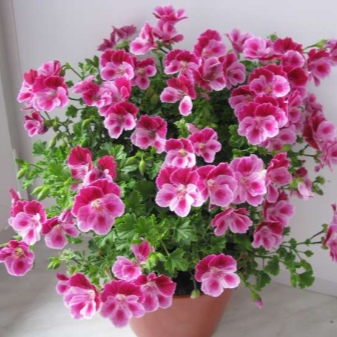
- "Angel Bicolor". It got its name from the contrasting color of the inflorescences: the large upper petals are crimson, the lower petals are pale pink, lavender.Blooms early, with careful care, pleases the owner with flowers until late autumn
The species is not planted in the garden, but kept indoors or on the veranda. Prefers diffused light and a cool room.
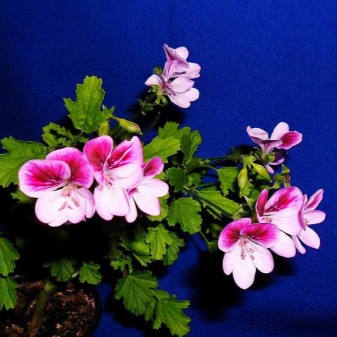
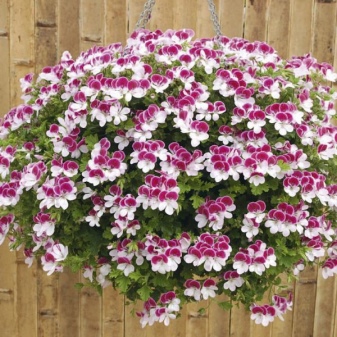
- "Angel Randy". Small-flowered pelargonium. It has small flowers about 2 cm in diameter, with crimson spots and light edging. Miniature carved leaves 1.5-2 cm in diameter. The stems are not straight, but slightly inclined, but with proper pruning, they form magnificently. In the ampelous version of planting, the branches fall in picturesque waves. According to flower growers, perennials are distinguished by longevity.

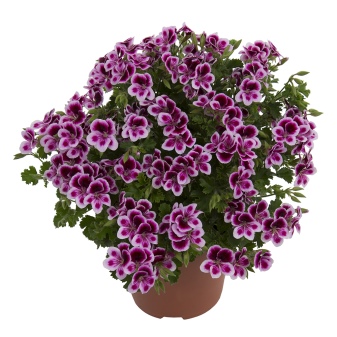
- "Angel Debbie"... Miniature bushes 20-30 cm high, their small size does not interfere with delighting with unusual flowers. The petals are indented along the edge, the upper ones are brightly colored, the lower ones are lightened. Woody straight stems, leaves are large in comparison with other hybrids.
For abundant flowering, regular pruning, fresh air and a cool winter are required.
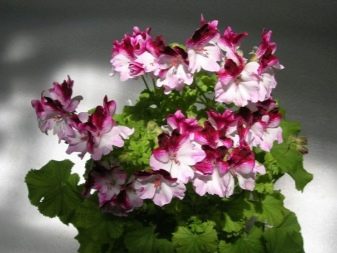

How to care?
Pelargoniums of this variety are grown both in a city apartment and on a personal plot. They grow well in group planting of 5 to 7 seedlings per container. For indoor keeping, this is also a suitable option. They tolerate dry air well in apartments, do not require the creation of a special microclimate, like orchids, or special conditions, like bonsai. But even the most unpretentious flowers must be looked after.
- Lighting. The plant is photophilous, but it grows well on the window, where the sun is only part of the day, and the rest of the time there is a light shade. A dense crown forms in a sunny place, shoots in the shade stretch out and hang over the edge, which looks good in hanging pots on the veranda.

- Temperature. Pelargonium does not tolerate a temperature drop below 8 degrees. In the spring and summer, it is better to take it out into the garden, on the balcony, or regularly ventilate the room. During the flowering period, the plant is sensitive to temperature extremes; care must be taken that the difference between day and night is not more than 5-7 degrees. Cool wintering is needed for budding in summer.

- Watering. Angel prefers warm and soft water. He does not like waterlogging of the soil, therefore, moderate watering must be observed in winter, while in summer, abundant watering is needed, as it dries. Lack of water leads to yellowing of leaves and lack of buds. The soil must be kept slightly moist. The plant does not require spraying, it tolerates the dry climate of a city apartment well.
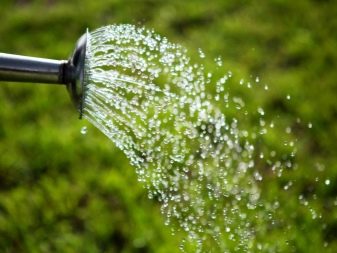
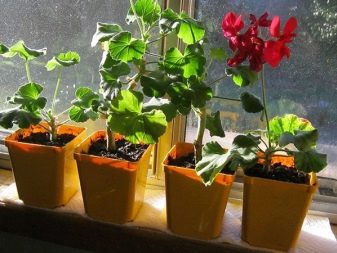
- The soil. The flower is suitable for soil for pelargoniums and geraniums or universal for flower plants. You can prepare the mixture yourself: take ordinary turf soil, add peat and some sand.
Important: before planting, the ground must be warmed up at a high temperature so that harmful bacteria and insects die.
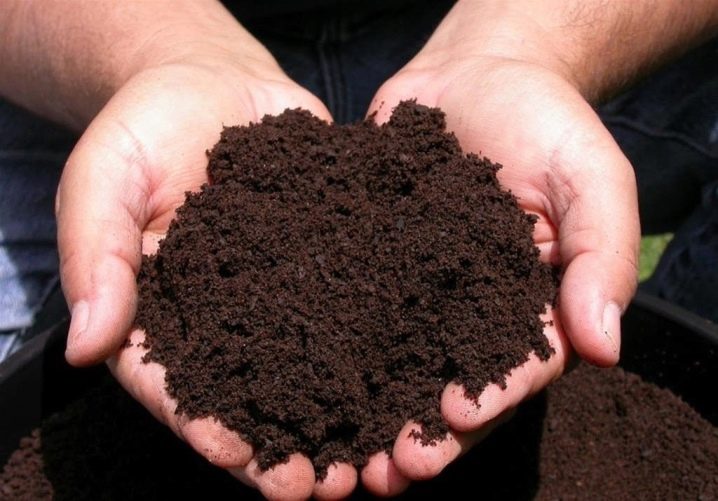
- Top dressing. Fertilizer is applied every two weeks from spring to late autumn. A complex fertilizer for flowering plants is suitable here. It is necessary to ensure that there is no excess of nitrogen, otherwise the buds will not appear, but the stems and foliage will develop strongly. During the budding period, it is better to choose phosphorus and potassium supplements.

- Pruning. Pelargonium is cut twice a year: in autumn and spring, sometimes in summer. In the fall, dried and excess shoots are removed, prepared for wintering. In spring and summer, unaesthetic parts, dried inflorescences or long stems are removed. An overgrown specimen produces fewer buds.
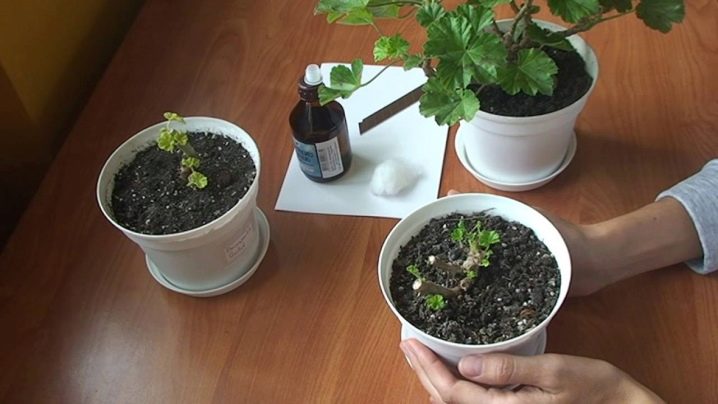
- Transfer. The plant is transplanted quite rarely. Small containers are usually used for flowering species. The capacity is taken a little more than the root volume. The huge pot stimulates the growth of roots, branches and crown rather than flowering. It is imperative to put drainage on the bottom. Stagnant water will have a bad effect on the seedling and can lead to diseases.
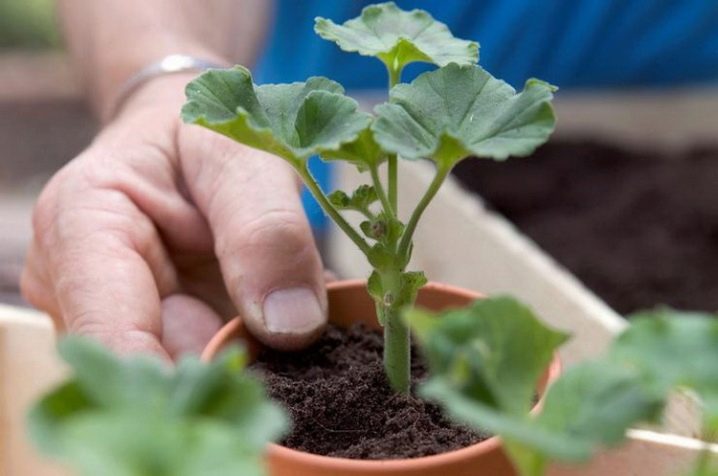
Reproduction
Flower shops often offer seeds and young seedlings for planting. Seedlings for open ground are annually obtained from the seeds. The resulting neat bushes look great in hanging flowerpots on the window and in containers on the balcony.
Sequence of planting seeds:
- the seeds do not need special preparation, they are planted from December to April;
- shallow containers are filled with a mixture of peat and sand;
- moisten the soil;
- the seeds are placed at a depth of about 5 mm;
- cover the container with polyethylene or glass;
- placed in a bright place;
- keep the soil moist for about 2 weeks, the temperature is within 22-24 degrees;
- when the first shoots appear, the cover is removed;
- transplanted after the appearance of the fourth leaf.
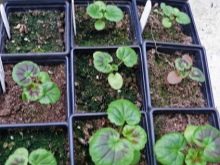
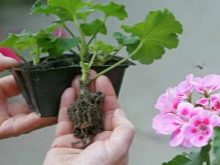
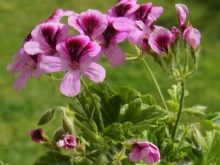
Stores often offer to buy cuttings. Propagation by cuttings is a common way to grow a young seedling. It develops and blooms faster than that obtained from seeds.
Cutting an adult bush is not much different from dividing other varieties of geraniums:
- 10 cm long shoots are cut off, 1-2 leaves are left on them;
- give several hours to dry;
- placed up to the twigs (most of the cutting) in wet sandy-peat soil;
- after 2-4 weeks, the seedlings take root;
- watered as the soil dries up along the edge of the container.
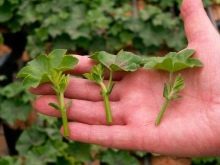

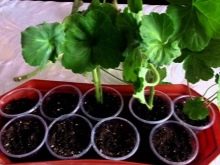
Sometimes growers put cuttings in water, but this is not recommended to avoid decay.
See the video about pelargoniums below.































The comment was sent successfully.